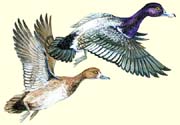Where We Live
 |
by Steve Carr |
Winter Shades
Nature has finished a masterpiece entitled Bay Gray
It’s cold ’round here in winter. Oh sure, it’s been a mild one so far, like it’s maybe North Carolina instead of the frigid Northeast, but winter’s still made some harsh changes to our surroundings.
Winter deadens everything, and colors seem less vibrant and alive. We bundle up and bumble along, missing the subtle contrasts as the countryside turns from green to brown, and the cold wind rules.
Walking around an old farm on the Broadneck Peninsula, I was enjoying the afternoon mass in the church of nature. At first the landscape looked rather dreary and forlorn. The water and the sky seemed to blend together almost seamlessly. In between, the skeleton trees rocked back and forth on the horizon like giant paintbrushes finishing off a masterpiece entitled Bay Gray.
Down the trail, I realized that the water of Whitehall Bay was not really gray but rather moonlit quicksilver. It didn’t flow but shimmered. Without wind or boat wakes, the surface appeared almost solid, like you could walk on it.
The next thing that caught my eye was ducks, mostly scaup, with a few buffleheads, canvasbacks and coots scattered here and there. For some reason, scaup really like Annapolis and have been wintering here in large numbers for the past few years. They have elegant black heads, black-and-white speckled backs and light-gray belly and sides. Those are, of course, the males. As with most species in the animal kingdom — except humans and a few other oddities — the males are quite colorful while the females look rather drab.
On some limestone boulders I sat and watched a very large freighter make its way slowly toward Baltimore, barely fitting under the Bay Bridge and looking psychedelic when the sun suddenly broke through the clouds and lit the ship with a day-glo orange spotlight.
Back at the duck follies, ring-billed gulls were causing trouble. Scaup are diving ducks, so they were constantly vanishing underwater before bobbing back up with whatever plant seed or crustacean they happened to find on the bottom. The punkster gulls shadowed the scaup to steal food, but the ducks were just too slick, and the gulls nabbed only the occasional scrap. Wouldn’t it just be easier to go find your own food? I asked them.
The sky turned dark as cloud fleets rolled in from the west and the sun played peek-a-boo from behind the moving slideshow of cirrus gray curtains. Airplane contrails sketched long white lines across the horizon, only to turn into puffy clouds that joined the procession heading toward the Eastern Shore.
Sure, vegetation goes dormant and loses its color in winter. It’s morphed into downtime mode, shedding its vibrant greens and flowery brilliance for something equally mesmerizing. From phragmites to fescue, the grasses go from green to a dry and brittle straw. They chatter in the breeze, each variety making a slightly different sound, like musical instruments in some north-wind orchestra.
The woods along Burly Creek offered another lesson in faded colors. We all know that evergreens stay green year round, but they are few and far between in the rich loamy soils of the coastal plain. Much of the remaining green comes from clumps of that non-native but sweet-smelling pest honeysuckle. It climbs into small trees and balls at the top like a leafy hat. We don’t even notice during the summer when this Asian transplant is spreading a mile a minute. But come winter, the green tree we think we’re seeing is a red bud or poplar whose canopy has been smothered by hibernating honeysuckle.
Other invasive plants add color to the winter landscape. Multiflora rose thickets are like a tangle of red snakes. English ivy wraps itself around the nearest anything and makes for the sky. And the greenbrier complements the color scheme by blanketing the woody lowlands like green razor wire.
Winter has painted a masterpiece. But as I get older, the cold becomes harder to handle. We really haven’t had any bone-chilling storms yet, but you can bet there are still a few nasty blizzards heading our way before the warmth of spring arrives for good.
The way I look at it, every winter day that goes by without the polar freeze is one less day we can get hammered. And hey, we only have six more weeks until we can burn our socks.